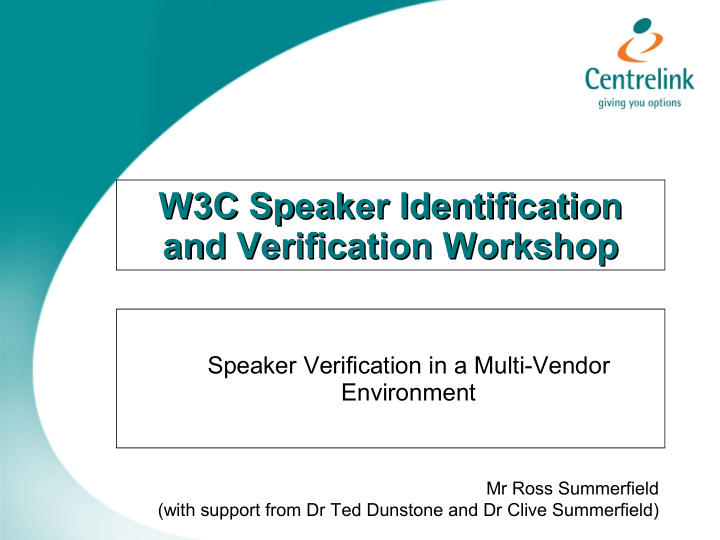



W3C Speaker Identification W3C Speaker Identification and Verification Workshop and Verification Workshop Speaker Verification in a Multi-Vendor Environment Mr Ross Summerfield (with support from Dr Ted Dunstone and Dr Clive Summerfield)
What is Centrelink? What is Centrelink? Equivalent to the US Department of Social Security Centrelink is an agency within the Australian Department of Human Services Mission is: • Serving Australia by assisting people to become self-sufficient and supporting those in need. Service provider to over 20 government departments Including FaHCSIA, DVA, DEEWR, DAFF, DHA Services 6.5 million customers Includes delivery of a range of payments to Australians, including people with disabilities, retirees, families, carers, parents, Indigenous people and people from diverse cultural and linguistic backgrounds. Also includes crisis referral and disaster response. Has the largest call centre in the southern hemisphere More than 32 million phone calls per year Has web self services based around portals More than 18 million on-line transactions per year.
Overview of Centrelink's Overview of Centrelink's Speaker Verification system Speaker Verification system Identity and authentication is central to Centrelink’s services Multi-algorithm solution Provided by two vendors, using an integration component (VACM) Built for semi-complex 2-factor authentication (to Australian Government Authentication Framework standards) SV Currently sits in an IVR environment Proprietary Intervoice IVR Nuance's (Speechworks vintage) Natural Language Speech Recognition • plans to upgrade Nuance Text to Speech Web Services based
Centrelink's deployment Centrelink's deployment Conducted a proof of concept, followed by a pilot, followed by a production deployment Stage-gate based approach to careful consideration of using this biometric based security service • Conducted over a period of nearly 5 years (from concept) • Included community and privacy group consultation • Each stage successful Built as an initiative of data security (Run from S&IP branch) Currently being rolled out to high volume telephone callers Considering offering it to enable employment declaration processing initially over the telephone possibly over the web in the future • Other multi-factor credentials are also being considered • It would be part of a mix of credentials available
Centrelink's future intentions Centrelink's future intentions Propose to incorporate SV wholly into the security services Speaker verification is seen as a security credential used for confirming an identity, rather than being a component of a user interface. Becomes part of a security solution suite to assure identity • providing authentication services to the IVR • and providing authentication services to web still operating as a web service (as per our security services) Considering using its text independent features in the future
Centrelink's current system Centrelink's current system
Centrelink future directions Centrelink future directions
Data Content Data Content For the biometric only (step 1) authentication: Initialisation • Provides: – customer access number (CAN) (from IVR) • Receives: – registration profile (identifier as known by SV and details around the enrolment) Authentication: • Provides: – calculated result and scores from each engine for the combination of CAN, name and random digit measurements » scores logged for audit and legal purposes • Receives: – Question set to ask and rules around question processing
Data Content Data Content For the secret question and answer (step 2) authentication: Initialisation • The already received question identifiers and rules Authentication: • Provides: – calculated result and scores from each engine for the answer to the secret question measurements • Receives: – calculated authentication status (i.a.w. AGAF process)
VoiceXML – How it can help us VoiceXML – How it can help us Parallel processing and pipe-lining Current customer experience is gaps between requests for data and the associated provision and the next request • Speaker verification could be processing in the background while the next request and acquisition is made Better support for streaming to both speech recognition as well as speaker recognition Some speech requires both recognition and speaker authentication • recognition is also a part of the authentication mix
Standards for Speaker Standards for Speaker Verification Verification For Centrelink (and the Australian Government in general), web services are important All our security services are web services based Our web pages are all portal based (Websphere) ISO standards (CBEFF and BioAPI) are a good start but they are not web services based Australian Biometrics Institute Privacy Code of Conduct Because privacy is a fundamental human right under the charter of 1948 Voice samples and templates should be treated as personal information Encryption is extremely important for biometrics It is very much about perception: • being seen to be doing everything possible to protect the credentials • Most important for opt-in (and opt-out) systems As voice data is indeed a very powerful biometric identifier, this data collection has very important implications for speech recognition systems
Standards for Speaker Standards for Speaker Verification Verification Support in VoiceXML is probably not important to us since we are moving to use it as a piece of the security infrastructure • not the voice interface Centrelink approaches speaker verification from a security perspective rather than a user perspective • therefore not seen to be part of the user interface layer the technology is not considered by Centrelink to be a component of speech recognition • but a technology for enhancing security and identity authentication process
A proposed arrangement: A proposed arrangement: Pictorial outline Pictorial outline
A proposed arrangement: A proposed arrangement: Pictorial outline Pictorial outline
Questions Questions
Recommend
More recommend